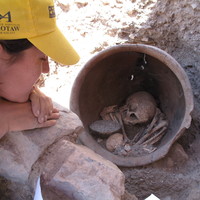Mireia Ache
Universitat Autònoma de Barcelona, Departament de Prehistòria, Graduate Student
- Archaeology, Prehistoric Archaeology, Mediterranean prehistory, Bronze Age Europe (Archaeology), Archaeometallurgy, Geoarchaeology, and 8 moreArgar Culture, El Argar, Ancient Architecture and Construction History, Grinding tools technology, Cupules, Prehistoric Fortification (Archaeology), Early Bronze Age (Archaeology), and Iberian Prehistory (Archaeology)edit
En: Juan Francisco Gibaja Bao, Millan Mozota Holgueras, Maria Eulalia Subira Galdacano & Araceli Martin Colliga (coords.) (2019) - Mirando a la muerte : las practicas funerarias durante el Neolitico en el noreste peninsular. Volumen 3,... more
En: Juan Francisco Gibaja Bao, Millan Mozota Holgueras, Maria Eulalia Subira Galdacano & Araceli Martin Colliga (coords.) (2019) - Mirando a la muerte : las practicas funerarias durante el Neolitico en el noreste peninsular. Volumen 3, Castello de la Plana, E-DitArx, 388 p. (Col.: Akademos; 3). ISBN: 978-84-946902-7-3.
Research Interests:
Research Interests:
Research Interests:
Research Interests:
Antolin, F; Ache, M; Bergada, M.M; Blasco, A; Buxo, R; Edo, M; Gibaja, J.F; Mensua, C; Palomo, A; Pique, R; Ruiz, J; Sana, M; Verdun, E; Villalba, M.J. 2011 in Blasco, A; Edo, M; Villalba, M.J. (coord). La cova de Can Sadurni i la... more
Antolin, F; Ache, M; Bergada, M.M; Blasco, A; Buxo, R; Edo, M; Gibaja, J.F; Mensua, C; Palomo, A; Pique, R; Ruiz, J; Sana, M; Verdun, E; Villalba, M.J. 2011 in Blasco, A; Edo, M; Villalba, M.J. (coord). La cova de Can Sadurni i la prehistoria de Garraf. Actes de les Jornades Internacionals de Prehistoria "El Garraf, 30 anys d'investigacio arqueologica". Begues, 5 al 7 de desembre de 2008. Col·leccio Actes. EDAR-Hugony editore. Milano. 2011.
Research Interests:
Research Interests:
This doctoral thesis is framed within the study of Late Prehistory of South-East Iberia, specifically focused on the Argaric Horizon (2200-1550 cal ANE); the research line of Bastida-UAB Project from the Prehistory Department of... more
This doctoral thesis is framed within the study of Late Prehistory of South-East Iberia, specifically focused on the Argaric Horizon (2200-1550 cal ANE); the research line of Bastida-UAB Project from the Prehistory Department of Autonomous University of Barcelona. The Argaric period implies important economic, technologic and social changes manifested in social hierarchy, economic inequality, proliferation of metallurgy and institutionalization of violence. Stone tools are an important testimony of productive activities. Their inorganic composition guarantees, in most cases, a good preservation level compared to perishable materials. Besides, their definition as means of production favors their wider representation in the archaeological record, unlike consumer goods. On an analytical level, these artifacts can be explored through three expression perspectives, a system that has been used to structure this dissertation. The theoretical approaches, objectives and general structure are described in chapter 1. The object of this study of this essay is the lithic artifact record of three settlements of the Region of Murcia: La Bastida, Tira del Lienzo (Totana) and Puntarrón Chico (Beniaján). In a novel way, we include the study of a representative sample of the constructive materials of the structures from La Bastida and Tira del Lienzo. Chapter 2 is dedicated to the geographic location and descriptions of the characteristics of each settlement, their documented spaces and chronological sequence, and a general presentation of the analyzed record. On chapter 3, the delimitation of the sources of the raw materials is defined. The interpretative objective is to determine the value of production of the artifacts in connection with the labor invested into provisioning their geologic foundation. The chapter is structured through the petrographic determination from archaeological and geological samples identified in La Bastida. These samples serve as a reference to the geological identification of the archaeological materials. The provenance analysis is made through a geomorphological description of the primary sources and the geological prospection of secondary deposits. Chapter 4 is dedicated to the research of the ecofacts from La Bastida and Tira del Lienzo. Their examination is addressed from three analytic perspectives: supplying and preparation of the materials, selective use according to technic and architectonic features, and evolution of constructive strategies and techniques during the different occupation phases of the settlements. Chapter 5 brings forward the data referring to morphometric and functional analysis. The study is focused on the description and interpretation of the morphometric and traceology variables of the artifacts. In this section, the results from a sequence of analysis of organic and inorganic residues are presented. This data includes X-Ray diffraction spectroscopy (XDS), phytoliths and starch analysis, mass-selective detection in gas chromatography (GC/MS) and the mineralogic determination obtained by X-Ray Diffraction (XRD). The interpretative outcome of these tests intends to infer new conclusions about the resulting productivity from technological processes. In chapter 6 the chrono-spatial analysis of the tools is examined. To get a closer look at the economic structure provided by archaeological contexts, the information is organized by the economic markers of the different activities, regarding their diversity, dominance, and ubiquity. As a conclusion, chapter 7 offers a synthesis of the results obtained in each step of the research. In this integration, the economic dynamic of La Bastida and Tira del Lienzo is interpreted in an explicative manner, making special emphasis on the relationship that existed between both settlements and the role they performed in their territory.
